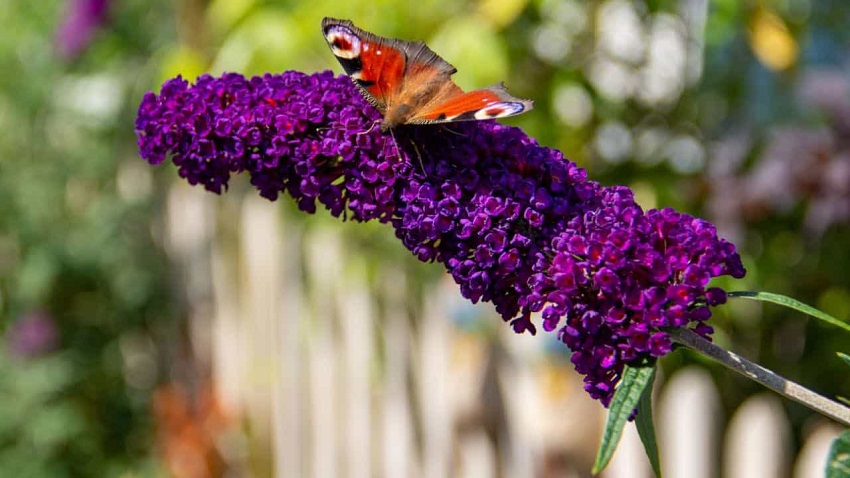
Butterfly bushes (scientific name: Buddleja) are beautiful flowering shrubs that not only add vibrant colors to your garden but also attract butterflies and other pollinators. To ensure your butterfly bush thrives and brings joy to your outdoor space, proper care is crucial. In this article, we will guide you through essential tips and techniques for successful butterfly bush care. From selecting the right variety to maintenance practices, we’ve got you covered.
Butterfly bushes are known for their long, cone-shaped flower clusters that bloom in various shades of purple, pink, white, and yellow. These fast-growing shrubs can reach impressive heights, making them a striking focal point in any garden. Besides their aesthetic appeal, butterfly bushes play a vital role in supporting butterfly populations and providing nectar for other pollinators.
Choosing the Right Butterfly Bush
When selecting a butterfly bush for your garden, consider factors such as growth habit, size, and flower color. Popular varieties like “Black Knight” and “White Profusion” offer different characteristics and can complement your garden’s design. Additionally, understanding the growth habits of butterfly bushes will help you choose the right location and ensure adequate space for their development.
Site Selection and Preparation
Butterfly bushes thrive in full sun and well-drained soil. Choose a location that receives at least six hours of direct sunlight per day. The soil should be loose, fertile, and well-draining. If your soil is heavy or clayey, consider amending it with organic matter to improve drainage and nutrient content. Proper site preparation sets the foundation for healthy growth.
Planting Butterfly Bushes
The ideal time to plant butterfly bushes is in spring or fall when the weather is mild. Ensure proper spacing between plants to allow for adequate air circulation and growth. Dig a hole slightly larger than the root ball, place the plant in the hole, and backfill with soil. Water thoroughly after planting and add a layer of mulch to conserve moisture and suppress weeds.
Watering and Fertilizing
Proper watering is essential for the health of your butterfly bush. Deep, infrequent watering encourages root development and drought tolerance. Provide one inch of water per week, either through rainfall or supplemental irrigation. When it comes to fertilizing, choose a balanced slow-release fertilizer and apply it in early spring. Organic alternatives like compost can also provide the necessary nutrients.
Pruning and Deadheading
Regular pruning is vital to maintain the shape and size of your butterfly bush. Prune in early spring before new growth appears, removing dead or damaged branches. Deadheading spent flowers throughout the blooming season promotes continuous flower production. Cut the flower clusters just above a leaf node to encourage new growth and more blooms.
Pest and Disease Control
While butterfly bushes are generally resilient, they can occasionally face pest and disease issues. Common pests include aphids, caterpillars, and spider mites. Monitor your plants regularly and take prompt action if you notice any infestations. Organic methods like insecticidal soaps and neem oil sprays can effectively control pests. Regarding diseases, keep an eye out for powdery mildew and root rot, and apply appropriate treatments if needed.
Winter Protection
Butterfly bushes are generally hardy, but providing some winter protection can ensure their survival in colder regions. Before the first frost, apply a layer of mulch around the base of the plant to insulate the roots. You can also wrap the shrub in burlap or cover it with a frost cloth to protect against freezing temperatures. Remove the winter protection in early spring when the danger of frost has passed.
Attracting Butterflies and Pollinators
One of the main reasons for planting butterfly bushes is to attract butterflies and other pollinators. Create a butterfly-friendly environment by incorporating other nectar-rich plants in your garden. Flowers like coneflowers, bee balm, and milkweed will entice a variety of butterflies. Additionally, provide shallow dishes of water and flat rocks for butterflies to rest and drink.
Propagation Methods
If you want to expand your butterfly bush collection or share plants with friends, several propagation methods can be employed. You can start new plants from seeds, take cuttings from existing plants, or divide mature plants. Each method has its own requirements and success rates, so choose the one that suits you best.
Troubleshooting Common Issues
Sometimes, despite your best efforts, issues may arise with your butterfly bushes. Yellowing or browning leaves can indicate nutrient deficiencies or watering problems. Poor blooming or lack of growth may be due to insufficient sunlight or pruning at the wrong time. Overwatering and drainage problems can lead to root rot. Identifying and addressing these issues promptly will help your plants recover.
Best Practices for Maintenance
To ensure your butterfly bushes remain healthy and vibrant, follow these maintenance practices. Regularly monitor your plants for signs of pests, diseases, or nutrient deficiencies. Remove spent flowers to promote prolonged blooming. Prune your butterfly bushes annually to maintain their shape and size. Conduct soil tests periodically to determine any necessary amendments and provide your plants with the best care possible.
Here are some best practices for butterfly bush care:
- Planting and Location:
- Choose a well-draining location with full sun exposure for your butterfly bush.
- Ensure there is enough space for the shrub to grow, as they can reach a height and spread of 6 to 10 feet (1.8 to 3 meters).
- Watering:
- Provide regular watering, especially during dry spells or in the first year after planting.
- Water deeply, allowing the soil to soak, but avoid overwatering, as butterfly bushes prefer slightly dry conditions.
- Pruning:
- Prune your butterfly bush annually in late winter or early spring before new growth begins.
- Remove dead, damaged, or crossing branches.
- Cut back the shrub to about 12 inches (30 cm) above the ground to encourage vigorous growth and a compact shape.
- If you prefer a taller or more natural-looking bush, you can prune less aggressively.
- Fertilization:
- Butterfly bushes are generally low-maintenance and do not require heavy fertilization.
- If the soil is poor or lacking in nutrients, you can apply a balanced, slow-release fertilizer in early spring.
- Mulching:
- Apply a layer of organic mulch around the base of the shrub, such as wood chips or compost.
- Mulching helps retain moisture, suppresses weeds, and improves soil health.
- Pest and Disease Management:
- Butterfly bushes are generally resistant to pests and diseases.
- However, they can occasionally be susceptible to spider mites, caterpillars, or powdery mildew.
- Inspect your plants regularly and take appropriate measures if any issues arise, such as using insecticidal soap or horticultural oil for pests, or a fungicide for powdery mildew.
Conclusion
Butterfly bushes are not only beautiful additions to your garden but also valuable sources of nectar for butterflies and other pollinators. By following the tips and techniques on butterfly bush care, you can ensure your butterfly bushes thrive and provide a colorful spectacle in your outdoor space. With proper care, you’ll create an environment that supports these delicate creatures and enhances the beauty of your garden.





